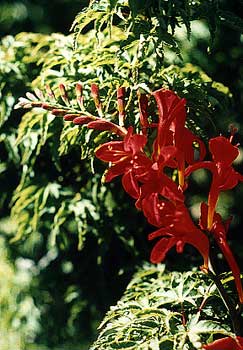
'Lucifer' Crocosmia
Crocosmia is a perennial sometimes known as Coppertip or Falling Star, & historically known as Tritonia & Monbretia. The latter name is after the French botanist Antoine Francois Ernest Conquebert de Monbret, who accompanied Napoleon on his 1798 campaign into Egypt.
Crocosmias are old to gardening, having been intensely hybridized in France since no later than the 1870s, & attracted English hybridizers by the mid 1890s. It is even so under-utilized, despite its extreme beauty & ease of care. Its lack of fashion has meant that of the dozens of cultivars developed between the 1879 & World War II, fully two-thirds have vanished from cultivation.
A hybrid Crocosmia masonorum x paniculata x crocusmiiflora is shown in a July portrait. It bears the cultivar name 'Lucifer' for its fiery redness. There are many other colors & varieties, but 'Lucifer' is the most popular throughout the American west & Northwest, for it possesses the deepest reds, is more than commonly appealing to hummingbirds, & performs well under a variety of conditions.
It was developed around 1966 by the English hybridizer Alan Bloom, of Blooms of Bressingham. That portion of its heritage which is C. masonorum & C. paniculata are true species crocosmias, but C. x crocumiiflora (formerly Montbretia crocosmiaeflora) designates an interspecific hybrid that had its beginnings in France in 1879 when Victor Lemoine first crossed C. aurea with C. pottsii.
An iris-family perennial closely related to gladiola, crocosmia has the same saber-shaped leaves as gladiola, often three feet tall or taller. It sends upward at at three to five foot sweep a marvelous flower stock. The photo here shows one panicle which is five feet up at about eye level. It is shown against the leaves of a nearby Lion's-head Maple, though a year after this photo the clump of 'Lucifer' was moved to another garden where it would have more room to spread.
This native of South Africa likes full sun (especially here in the Northwest) though it will tolerate partial shade (the further south it is grown, the more shade it can stand). I've seen it growing in considerable shade locally, but without plenty of sunlight & watering it remains a much shorter clump of swords, & flower stems are shorter & fewer.
It is not fussy as to its soil requirements, but well-drained enriched sandy soil is best. An underlayer of sand beneath the corms will insure good drainage, as the corms will rot if they are too wet. After the first year in the ground, it becomes relatively drought tolerant, though its large grass blades may die back prematurely if summer is too dry, whereas with light watering, & by taking some of the blossoms for bouquets, it will last until the first frost of autumn with continuous rebloom.
If temperatures are apt to drop into the twenties or teens, it should be mulched for winter. If winters are truly harsh, it may be necessary to dig up the corms in Autumn to replant the following season. 'Lucifer' happens to be even more cold-hardy than other varieties, & can be grown in USDA zone 5 without special protection. On Puget Sound (zone 8) crocosmias are left in the ground without worry.
See also
C. x crocosmiflora 'Emily Mckenzie'